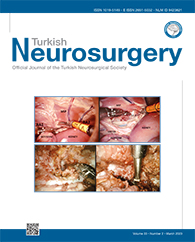2Ankara University, School of Medicine, Department of Anatomy, Ankara, Turkey
3Yuksek Ihtisas University School of Medicine, Department of Neurosurgery, Ankara, Turkey
4Ankara Memorial Hospital, Department of Neurosurgery, Ankara, Turkey
5Kirikkale University School of Medicine, Department of Otolaryngology, Kirikkale, Turkey
6Ankara University School of Medicine, Department of Neurosurgery, Ankara, Turkey DOI : 10.5137/1019-5149.JTN.41572-22.3 AIM: To describe in detail the gross anatomy of the superficial temporal artery (STA), its course and branches, its relationships with the branches of the facial nerve, and certain anatomical and surgical landmarks to preserve these structures in daily neurosurgical practice, and to use the STA during revascularization surgery.
MATERIAL and METHODS: This cadaveric study was conducted on 16 cadaver heads bilaterally, in which 32 silicon/latex-injected STAs were dissected using a microdissection technique in a neuroanatomy laboratory. The distances between the facial nerve, tragus, STA, superficial temporal vein (STV), and imaginary lines created between important anatomical landmarks were measured. The curvilinear lengths of STA and STV were also measured.
RESULTS: The average distances of the most posteriorly located branch of the facial nerve to the frontal region and the tragus at the midpoint of zygoma in the horizontal plane, at the superior border of the zygoma and at the level of the superior border of the parotid gland, were measured as 25.39, 29.84, and 15.56 mm, respectively. The average distance directly measured between the tragus and STA was 39.29 mm, and that between the tragus and STV was 20.26 mm. The average curvilinear lengths of the frontal and parietal branches of STA were 97.63 and 96.45 mm, respectively.
CONCLUSION: Understanding the clinical anatomy of the STA and its branches and its relationships with other structures is of critical importance for a successful and noncomplicated surgery. Our findings will be useful not only for surgical approaches such as pterional craniotomy and orbitozygomatic approaches but also for cerebral revascularization.
Keywords : Anatomy, Cadaver, Anatomic study, Superficial temporal artery, Superficial temporal vein




